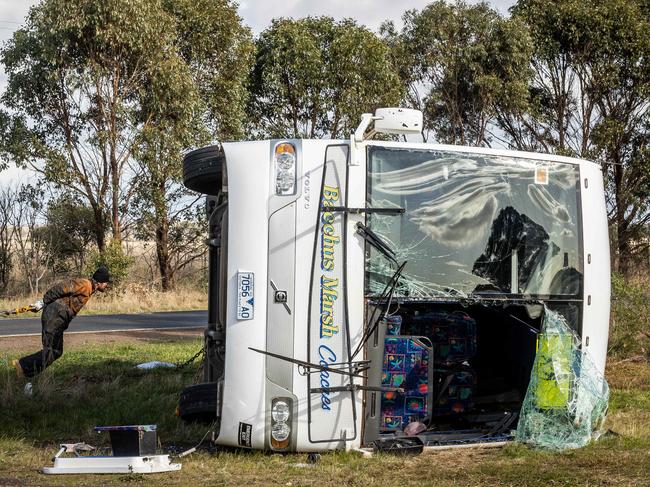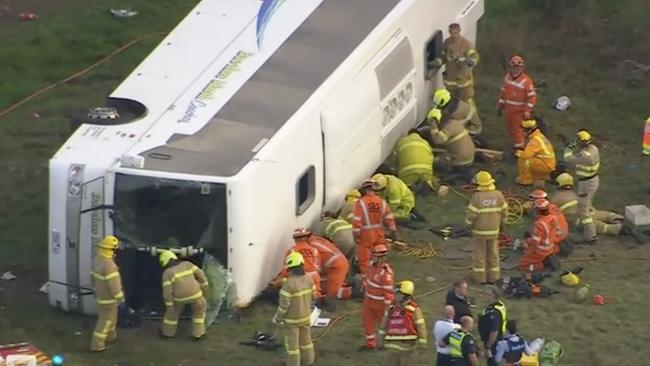Hunter Valley bus crash victims ‘shouldn’t have died’ if better safety measures in place: experts
From glass windows that protect passengers, to seatbelt alerts, automatic braking and safer guard rails – the experts say we can do better when it comes to bus safety.
NSW
Don't miss out on the headlines from NSW. Followed categories will be added to My News.
The Hunter Valley bus tragedy was a “very survivable crash” and passengers may not have died if better safety measures like safer window glass had been mandatory, electronic stability control installed and stricter seatbelt rules enforced, top road safety experts say.
The experts have expressed frustration with politicians and the nation’s bureaucracy in dragging their heels on much-needed road safety reforms – arguing that unlike the rapid response over Covid – “for road safety it somehow gets bogged down and people wind up dying”.
“The bureaucracy coming out of Canberra is so frustrating for road safety experts,” Professor Raphael Grzebieta, from the University of NSW’s Transport and Road Safety Research Centre, said.
“It seriously costs lives.”
“People shouldn’t have died in this crash.

“It was a very survivable crash.”
Among the measures that could have prevented or mitigated the tragedy are what are called “ejection mitigation rules”, where the window glass used is a laminated safety glass that contains passengers “a bit like a trampoline netting”.

The tougher glass, which must withstand tests simulating an unrestrained adult impacting a window in a rollover, has already been adopted in the USA for newer buses and vehicles.
“Definitely there is considerable scope for improving windows in buses to help prevent ejection in rollovers,” Prof Grzebieta said.
“We have now had two bus crashes with rollover where children were serious injured and now people have died.
“The Exford Primary School west of Melbourne where children lost limbs because of the lack of containment.

“In the Hunter Valley crash, the bus rolled onto a crash barrier. This wouldn’t have helped.
“Likely the barrier dug into the side of the bus as it slid across the top of it not unlike a chainsaw.
“Nevertheless the side windows should be made from safety anti ejection glass that is safe and does not lacerate people when they interact against it.”
In another bus rollover crash last November at Belmont near Newcastle, passengers also fell out the window and were injured.

Professor Grzebieta also said if Electronic Stability Control had been deployed on the bus it would have stopped the rollover. The technology intervenes and controls braking if it detects a vehicle is about to skid or lose traction.
It has now been mandated for new buses in Australia – but only for from 1 November 2024.
“That would have prevented the bus from rolling over in the first place,” he said.
“Had the Hunter Valley bus had ESC all the passengers would likely avoided any injuries.
“That’s the problem with Australia – why do we badly lag Europe in introducing such life saving systems?”
Another safety fix are guardrails – Prof Grzebieta and others had lobbied for guardrail barriers to have covers over the top of them to reduce the “chainsaw” effect of anything sliding on top.
“If the bus falling onto the crash barrier was a contributor to the deaths and serious injuries then why wasn’t the barrier made from a solid profile pipe or rectangular section or even concrete?” he said.
And much stricter seatbelt systems could have saved lives and need to be enforced, the experts say.
“Bus drivers should have a panel so they know when the belts activate, with an electronic trip switch,” motoring expert Ian Luff, from Motivation Australia, said.
Another safety measure that should be mandated are event data recorders (EDR), Prof Gabrielle said, to help police and coroners.
“There was a recent Australasian College of Road Safety seminar on vehicle safety standards where a Canberra bureaucrat made lame budgetary excuse as to why we still don’t have an EDR ADR in place mandating all vehicles have them.”





